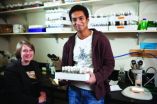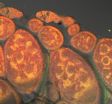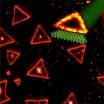(Press-News.org) BLOOMINGTON, Ind. -- A team of biologists from Indiana University and Brown University believes it has discovered the mechanism by which interacting mutations in mitochondrial and nuclear DNA produce an incompatible genotype that reduces reproductive fitness and delays development in fruit flies.
The new research, led by IU biologists Kristi Montooth and Colin Meiklejohn and including former IU undergraduate researcher Mo Siddiq, describes the cause and consequences of an interaction between the two genomes that co-exist within eukaryotic cells. Animal mitochondrial DNA, or mtDNA, is a small but important genome that encodes a handful of proteins that are essential to oxidative phosphorylation, the pathway that produces the adenosine triphosphate molecule that fuels cellular metabolism.
With this new characterization of a disruptive interaction between mtDNA and nuclear DNA mutations, the scientists provide one of the few mapped cases of a fitness-reducing mitochondrial-nuclear incompatibility.
The genetic interaction that IU biologists mapped, in collaboration with Brown University biologist David Rand, is between mutations that are present in natural populations, rather than being induced in the lab. This has important consequences for understanding genetically complex human diseases.
Many human diseases, such as neuromuscular and neurodegenerative disorders, are associated with mutations in mitochondrial transfer RNAs, or tRNAs, but a single mutation can be highly variable in the degree to which it leads to disease.
Montooth and her colleagues' findings suggest that the combined mitochondrial-nuclear genotype for tRNAs and their tRNA synthetases may, in fact, be a better predictor of disease.
"Interactions between mitochondrial and nuclear DNA for fitness have been documented in many organisms, but rarely has the genetic or mechanistic basis of these interactions been elucidated," said Montooth, an assistant professor in the IU College of Arts and Sciences' Department of Biology. "This has limited our understanding of which genes harbor variants causing mitochondrial-nuclear disruption and the processes that are impacted by the co-evolution of these genomes."
Using genetic techniques and many resources available from IU's own Bloomington Drosophila Stock Center, the scientists mapped an interaction between a single mutation in a mitochondrial tRNA gene, mt-tRNA-Tyr, and an amino acid change in its nuclear-encoded charging enzyme, the mitochondrially targeted amino acyl tRNA synthetase, mt-TyrRS -- the enzyme that places the proper amino acid on the tRNA to allow for mitochondrial protein synthesis.
"As a result, the incompatibility decreases the activity of the oxidative phosphorylation pathway," Montooth said, "demonstrating that decreased mitochondrial protein synthesis compromises the energetic function required for proper development of adult structures, such as the ovary and sensory bristles."
These types of fitness-reducing genetic incompatibilities are one hypothesized mechanism that can maintain the formation of new species.
INFORMATION:
The new research, "An Incompatibility Between a Mitochondrial tRNA and Its Nuclear-Encoded tRNA Synthetase Compromises Development and Fitness in Drosophila," was published online Jan. 31 in PLOS Genetics. Additional co-authors with Montooth, Meiklejohn, Siddiq and Rand were Marissa A. Holmbeck and Dawn N. Abt, both of Brown.
This research was funded by the National Institutes of Health, the National Science Foundation, IU and the IU Hutton Honors College.
Biologists map rare case of fitness-reducing interaction in nuclear, mitochondrial DNA
Incompatible genotype could be better predictor of genetically complex human diseases
2013-02-05
ELSE PRESS RELEASES FROM THIS DATE:
EARTH: Moon could have formed from Earth after all
2013-02-05
Alexandria, VA –Scientists are revisiting the age-old question of how Earth's moon formed with the development of two new models that work out the complicated physics of planetary collisions. The idea of a moon-forming collision is not new: The Giant Impact Theory put forth in the 1970s suggested that the moon resulted from a collision with a protoplanet approximately half the size of ancient Earth. But the physics underlying such a collision implied that the moon should be made up of debris mostly from the protoplanet. Since then we've discovered the moon is instead very ...
Mitochondrial mutations: When the cell's 2 genomes collide
2013-02-05
PROVIDENCE, R.I. [Brown University] — Diseases from a mutation in one genome are complicated enough, but some illnesses arise from errant interactions between two genomes: the DNA in the nucleus and in the mitochondria. Scientists want to know more about how such genomic disconnects cause disease. In a step in that direction, scientists at Brown University and Indiana University have traced one such incompatibility in fruit flies down to the level of individual nucleotide mutations and describe how the genetic double whammy makes the flies sick.
"This has relevance to ...
Old age offers no protection from obesity's death grip
2013-02-05
Obesity kills, giving rise to a host of fatal diseases. This much is well known. But when it comes to seniors, a slew of prominent research has reported an "obesity paradox" that says, at age 65 and older, having an elevated BMI won't shorten your lifespan, and may even extend it. A new study takes another look at the numbers, finding the earlier research flawed. The paradox was a mirage: As obese Americans grow older, in fact, their risk of death climbs.
Ryan Masters, PhD, and Bruce Link, PhD, at Columbia University's Mailman School of Public Health, in collaboration ...
Giving transplanted cells a nanotech checkup
2013-02-05
Researchers at Johns Hopkins have devised a way to detect whether cells previously transplanted into a living animal are alive or dead, an innovation they say is likely to speed the development of cell replacement therapies for conditions such as liver failure and type 1 diabetes. As reported in the March issue of Nature Materials, the study used nanoscale pH sensors and magnetic resonance imaging (MRI) machines to tell if liver cells injected into mice survived over time.
"This technology has the potential to turn the human body into less of a black box and tell us if ...
Next-gen e-readers: Improved 'peacock' technology could lock in color for high-res displays
2013-02-05
ANN ARBOR—Iridescence, or sheen that shifts color depending on your viewing angle, is pretty in peacock feathers. But it's been a nuisance for engineers trying to mimic the birds' unique color mechanism to make high-resolution, reflective, color display screens.
Now, researchers at the University of Michigan have found a way to lock in so-called structural color, which is made with texture rather than chemicals. A paper on the work is published online in the current edition of the Nature journal Scientific Reports.
In a peacock's mother-of-pearl tail, precisely arranged ...
Samoan obesity epidemic starts at birth
2013-02-05
PROVIDENCE, R.I. [Brown University] — As some Pacific island cultures have "westernized" over the last several decades, among the changes has been a dramatic increase in obesity. Researchers don't understand all the reasons why, but even a decade ago in American Samoa 59 percent of men and 71 percent of women were obese. A new Brown University study finds that the Samoan epidemic of obesity may start with rapid weight gain in early infancy.
The implications of the study published online in the journal Pediatric Obesity may not be confined to Polynesian populations, said ...
Light-emitting triangles may have applications in optical technology
2013-02-05
For the first time, scientists have created single layers of a naturally occurring rare mineral called tungstenite, or WS2. The resulting sheet of stacked sulfur and tungsten atoms forms a honeycomb pattern of triangles that have been shown to have unusual light-emitting, or photoluminescent, properties. According to team leader Mauricio Terrones, a professor of physics and of materials science and engineering at Penn State, the triangular structures have potential applications in optical technology; for example, for use in light detectors and lasers. The results of the ...
Some omega-3 oils better than others for protection against liver disease
2013-02-05
CORVALLIS, Ore. – Research at Oregon State University has found that one particular omega-3 fatty acid has a powerful effect in preventing liver inflammation and fibrosis – common problems that are steadily rising along with the number of Americans who are overweight.
The American Liver Foundation has estimated that about 25 percent of the nation's population, and 75 percent of those who are obese, have nonalcoholic fatty liver disease. This early-stage health condition can sometimes progress to more serious, even fatal diseases, including nonalcoholic steatohepatitis, ...
Tendency to fear is strong political influence
2013-02-05
It's no secret that fear is a mechanism often used in political campaigns to steer public opinion on hot-button issues like immigration and war. But not everyone is equally predisposed to be influenced by such a strategy, according to new research by Rose McDermott, professor of political science, and colleagues published in the American Journal of Political Science.
By examining the different ways that fear manifests itself in individuals and its correlation to political attitudes, the researchers found that people who have a greater genetic liability to experience higher ...
Vitamin D, omega-3 may help clear amyloid plaques found in Alzheimer's
2013-02-05
A team of academic researchers has pinpointed how vitamin D3 and omega-3 fatty acids may enhance the immune system's ability to clear the brain of amyloid plaques, one of the hallmarks of Alzheimer's disease.
In a small pilot study published in the Feb. 5 issue of the Journal of Alzheimer's Disease, the scientists identified key genes and signaling networks regulated by vitamin D3 and the omega-3 fatty acid DHA (docosahexaenoic acid) that may help control inflammation and improve plaque clearance.
Previous laboratory work by the team helped clarify key mechanisms ...
LAST 30 PRESS RELEASES:
Air pollution exposure and birth weight
Obstructive sleep apnea risk and mental health conditions among older adults
How talking slows eye movements behind the wheel
The Ceramic Society of Japan’s Oxoate Ceramics Research Association launches new international book project
Heart-brain connection: international study reveals the role of the vagus nerve in keeping the heart young
Researchers identify Rb1 as a predictive biomarker for a new therapeutic strategy in some breast cancers
Survey reveals ethical gaps slowing AI adoption in pediatric surgery
Stimulant ADHD medications work differently than thought
AI overestimates how smart people are, according to HSE economists
HSE researchers create genome-wide map of quadruplexes
Scientists boost cell "powerhouses" to burn more calories
Automatic label checking: The missing step in making reliable medical AI
Low daily alcohol intake linked to 50% heightened mouth cancer risk in India
American Meteorological Society announces Rick Spinrad as 2026 President-Elect
Biomass-based carbon capture spotlighted in newly released global climate webinar recording
Illuminating invisible nano pollutants: advanced bioimaging tracks the full journey of emerging nanoscale contaminants in living systems
How does age affect recovery from spinal cord injury?
Novel AI tool offers prognosis for patients with head and neck cancer
Fathers’ microplastic exposure tied to their children’s metabolic problems
Research validates laboratory model for studying high-grade serous ovarian cancer
SIR 2026 delivers transformative breakthroughs in minimally invasive medicine to improve patient care
Stem Cell Reports most downloaded papers of 2025 highlight the breadth and impact of stem cell research
Oxford-led study estimates NHS spends around 3% of its primary and secondary care budget on the health impacts of heat and cold in England
A researcher’s long quest leads to a smart composite breakthrough
Urban wild bees act as “microbial sensors” of city health.
New study finds where you live affects recovery after a hip fracture
Forecasting the impact of fully automated vehicle adoption on US road traffic injuries
Alcohol-related hospitalizations from 2016 to 2022
Semaglutide and hospitalizations in patients with obesity and established cardiovascular disease
Researchers ‘listen in’ to embryo-mother interactions during implantation using a culture system replicating the womb lining
[Press-News.org] Biologists map rare case of fitness-reducing interaction in nuclear, mitochondrial DNAIncompatible genotype could be better predictor of genetically complex human diseases



